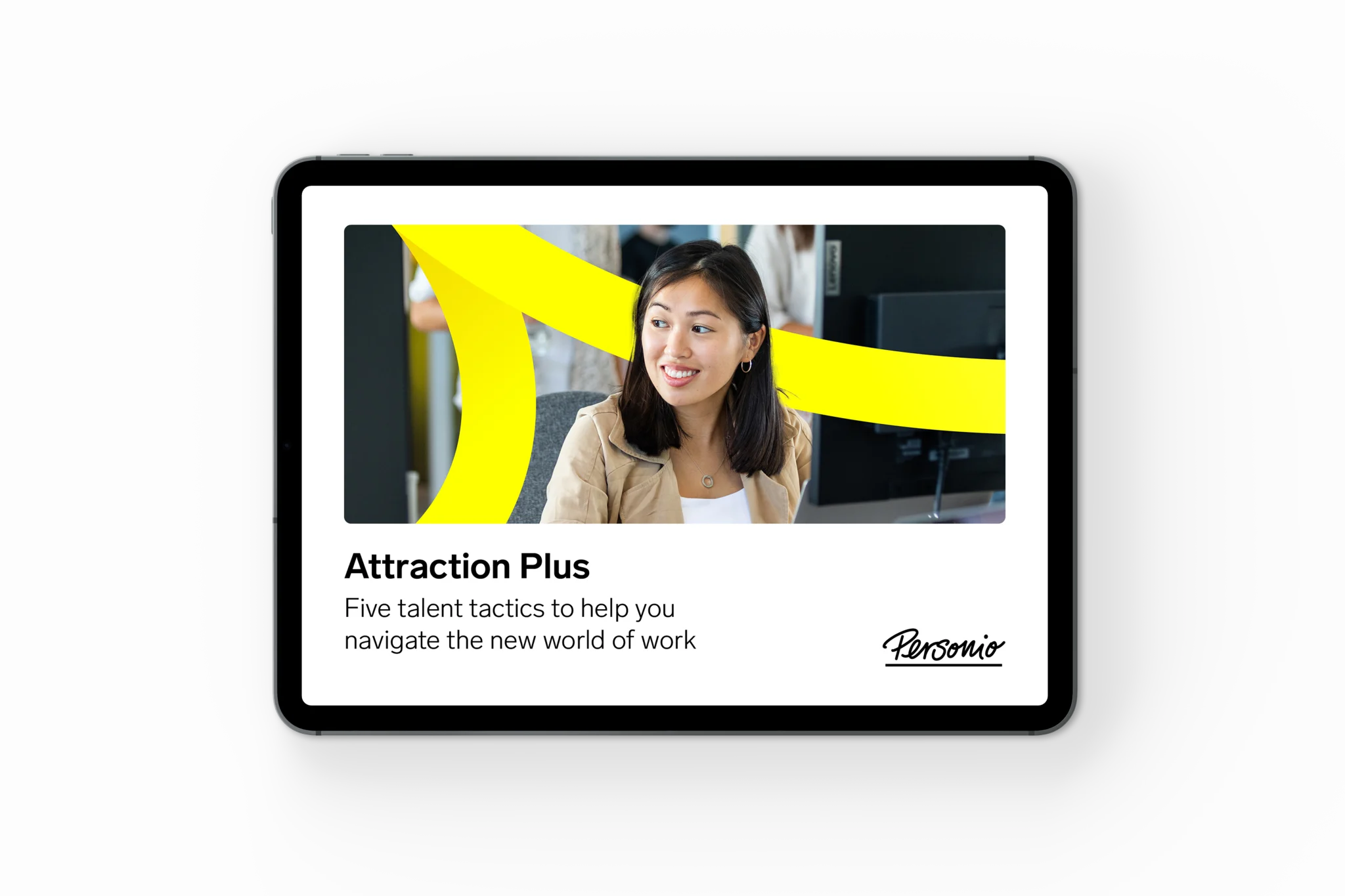The Critical Role of Great Talent Acquisition

Developing a robust talent acquisition strategy is key to taking recruitment to the next level. In this guide, we’ll explain the essentials of talent acquisition as well as how Personio’s talent acquisition software can transform your recruiting processes.
Key Facts
Talent acquisition is a long-term recruitment strategy to build a strong talent pool to continually pull from, ensuring the best candidate is hired for each role.
Talent acquisition looks ahead to the future, while recruitment is concerned with the present needs of the company.
There are six key steps to the talent acquisition process, taking candidates from lead generation to onboarding.
Contents
- 1What is Talent Acquisition?
- 2What is a Talent Acquisition Strategy?
- 3What Is the Difference Between Talent Acquisition and Recruitment?
- 4Talent Acquisition Best Practices
- 5Understanding the Talent Acquisition Process
- 6Top 5 Tips for Effective Talent Acquisition
- 7Frequently Asked Questions
- 8How Talent Acquisition Software Can Help
What is Talent Acquisition?
Talent acquisition is the strategic process of finding, qualifying and recruiting employees to your business. Talent acquisition identifies standout candidates and fosters relationships with them; so when a suitable vacancy arises, they are the first to be approached.
What is a Talent Acquisition Strategy?
A talent acquisition strategy requires taking a proactive approach to hiring. That means seeing recruitment as an opportunity, opposed to a requirement. Your talent acquisition strategy, overall, should align with (and even resemble) your workforce planning efforts.
What Is the Difference Between Talent Acquisition and Recruitment?
While it’s easy to treat talent acquisition and recruitment interchangeably, there are key differences between the two. Let us explain…
Think of talent acquisition as a way of future-proofing your business. By planning ahead and nurturing potential employees, you’ll be able to hire the best talent when you need it. Whether it’s for a more specialist role, a senior leader or an exceptional candidate, talent acquisition takes a more strategic approach to filling vacancies.Recruitment, on the other hand, is a short-term plan. It puts less emphasis on who is hired and more on when they are hired. While recruitment is still focused on bringing good talent into the business, it is more occupied with fulfilling the immediate needs of the company, as opposed to hiring the best candidate possible.
Discover how to foster and build your talent pool with Personio.
Talent Acquisition Best Practices
How you approach talent acquisition can vary depending on your business, but there are a few common strategies to keep in mind.
Use Data
Step one in developing a successful talent acquisition strategy is to assess your current recruitment process. Use the numbers you have available to establish what channels have worked best in the past, where top recruits came from, how effective your interview process is and so on. This is where the use of a talent acquisition software is invaluable, as it will do all the number crunching for you.
Build a Strong Employer Brand
Building a strong employer brand is one of the best ways to attract talent to your business. But how is it done? First, think about the image you’re presenting to future candidates.
What do your website and social media profiles say about you? Take the time to cultivate an image that showcases your company culture and accentuates the positives to attract top talents to you.
Focus on Diversity
A diverse workforce is a powerful workforce. People from different backgrounds and experiences can all bring something different to the table, so it’s important they have a seat at it.
Create a workplace that celebrates diversity, equity and inclusion from the top down, ensuring management sets an example. Apply the same strategy to talent acquisition to forge a strong, unbiased workforce.
Create a Candidate Pipeline
Focusing less on current business needs and more on future goals, proactively engage with candidates early to build a relationship and create a talent pipeline for upcoming roles. This can be particularly relevant regarding graduates; connecting with students before they graduate can put your business top of mind when they’re looking for that all-important job.
It also means holding onto applicants who may not have been right for the current position, but may be perfect for a future role.
Email Course: Talking All Things Talent in 5 Emails

Our latest talent email course offers an in-depth look into the many dimensions of talent. Win the competition for talent for your org by singing up today.
Sign Up NowUnderstanding the Talent Acquisition Process
No matter the size of your business, the same basic steps apply to the talent acquisition process…
1. Lead Generation
First and foremost, you need to generate a strong pool of talent.
This comes down to creating an enticing job advert and sharing it on the most appropriate channels for your business. This might be on your social channels, website or a third-party site like Indeed or LinkedIn.
Remember to use data from previous vacancies to help you decide where to look for candidates. Quality is often better than quantity, so you’d better be selective in where you post your job ad to ensure you get the most relevant candidates applying.
2. Selection Criteria
Next, you’ll want to narrow down your pool of applicants for the recruitment phase. Have a list of must-have skills and qualities you’re looking for and screen applications against the job description posted.
An important part of talent acquisition is keeping good candidates on file for future roles they may be suitable for, even if they’re not quite right for this one.
3. Interviews
Once you’ve narrowed down your list of candidates, it’s time to conduct some interviews!
Take time to design a list of questions to evaluate the candidate’s past experience, as well as attitude and personality for the best cultural fit. If you’ve had a lot of responses, you may not have time to do in-depth interviews with them all.
In this case, a brief phone or virtual interview can help you choose who to take to the next stage. At least one in-person interview is recommended to really get to know potential hires.
4. Check References
While it might be tempting to skip this stage if you’ve had great interviews with a candidate, checking their references is crucial. This can either confirm your feelings about them or reveal aspects that may have been missed. Find out how to conduct a great reference check and clarify whether or not to proceed with your preferred applicant.
5. Hiring
Once you’ve made a decision, you should make an offer. There might be some negotiation at this stage, particularly around salary, so it’s important to be flexible if you want the candidate to come aboard. Remember, the candidate is also deciding whether they want to work for you.
6. Onboarding
Recruitment doesn’t stop once the candidate has accepted the offer, You should have a solid onboarding process to welcome them to the company and help them hit the ground running. Support your new starters with adequate training, set up introductions with other colleagues and make yourself available for any questions they may have to make them feel comfortable. Poor onboarding can let down the entire talent acquisition process and may even lead to the candidate quitting.
Top 5 Tips for Effective Talent Acquisition
Take your time – from identifying candidates to the application process and interviews, truly effective talent acquisition takes time. Rushing the process now will only cost you time in the long run if you don’t select the best candidates for your business.
Get buy-in across the business – for talent acquisition to be successful, it needs to be at the centre of your recruitment strategy. From HR to team leaders, make sure everyone is on the same page for the best results.
Use referrals – don’t underestimate the power of referrals. Encourage your workforce to put forward candidates with an employee referral program; if you rate them, chances are they will recommend someone just as good.
Keep an eye on the competition – to attract the best, you need to offer the best. Keep an eye not only on the salaries offered by your competitors, but on the benefits too. Set yourself apart from the rest and make candidates an offer they can’t refuse.
Make it simple – while it’s important to suss out who the quality candidates are early on, keeping the application process simple will help to avoid drop-off. Use the interview structure and stage to get to know your candidates in more detail.
Frequently Asked Questions
What is The Difference Between HR and Talent Acquisition?
HR stands for Human Resources and is the part of a business responsible for managing its people, their wellbeing and workplace culture. They are primarily in charge of recruitment, taking care of current employees, any legal relations, and offboarding. Talent acquisition, on the other hand, is solely focused on finding, fostering and hiring new employees to the business.
What Skills Are Needed for Talent Acquisition?
As a core part of recruitment, your talent acquisition team should have excellent communication skills to approach candidates and nurture strong relationships with them. Good organisational and planning skills are also important to stay on top of the recruitment process, which can be helped with talent acquisition software. Analytical skills will also help to assess the data provided by this software and help to narrow down the talent pool. Your talent acquisition team should also be skilled negotiators to get the best deal for both the business and the candidate.
What is a Talent Acquisition Example?
Several talent acquisition strategies can be applied to achieve results, such as prioritising diversity to create an unbiased workforce. If you haven’t already, start to integrate diversity, equity and inclusion into everything you do and promote these beliefs from management down to create a culture that will attract the right talent.
What is The First Step In The Talent Acquisition Process?
The first step in the talent acquisition process is generating leads to build a good talent pool. Work on creating enticing job adverts and promote them in the best channels for your business, whether that be owned channels like your social media or third-party sites like Indeed.
Why Do We Need Talent Acquisition?
Talent acquisition is essential for the future of your business. Taking time to source and hire the best employees for each role will lead to less churn and help build a strong company culture that will continually attract great talent to the business. While it can be a long process, talent acquisition can help to simplify recruitment down the line when you have an invaluable talent pool available at your fingertips for new roles.
Don’t stop at talent acquisition – learn how to build an efficient talent management strategy to upskill and retain your workforce.
How Talent Acquisition Software Can Help
Talent acquisition might seem like a daunting process, but you’re not alone – software like Personio can help make things easy. From sourcing applicants to tracking candidates and nailing the onboarding process, Personio offers an all-in-one talent acquisition software that can automate and streamline vital steps in the process. Crucially, it will amass helpful data you can use for future vacancies and a pool of candidates that’s essential to talent acquisition.
Book a demo today to see how Personio can help you find new talent.
Disclaimer
We would like to inform you that the contents of our website (including any legal contributions) are for non-binding informational purposes only and does not in any way constitute legal advice. The content of this information cannot and is not intended to replace individual and binding legal advice from e.g. a lawyer that addresses your specific situation. In this respect, all information provided is without guarantee of correctness, completeness and up-to-dateness.


